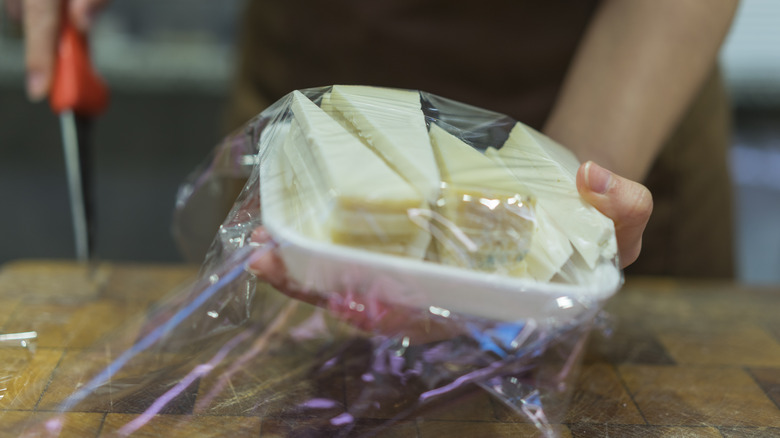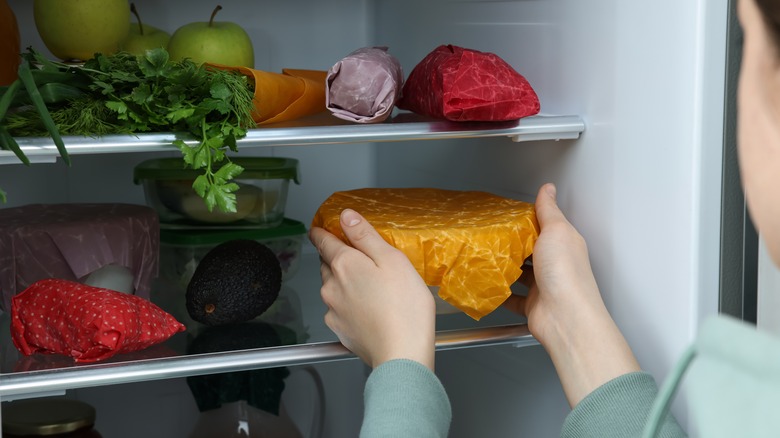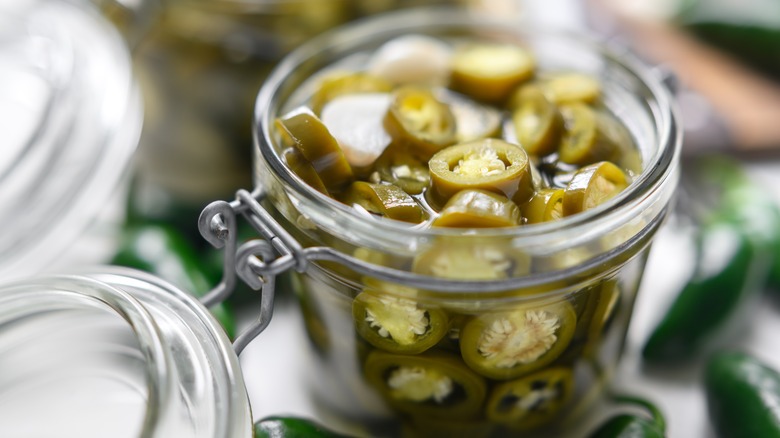Why It's Time To Ditch The Plastic Wrap (And What You Should Start Using Instead)
We may receive a commission on purchases made from links.
Plastic cling wrap is a common sight in many domestic kitchens, being a largely food-safe method of sealing open containers to slow spoilage via air exposure, as well as locking in smells. However, it might not be worth buying a new box. Plastic wrap is one of many sources of microplastics in your life, or plastics that are less than five millimeters in length and survive long after the material is degraded. According to Stanford University, as many as 40 million metric tons of microplastic particles are released into the environment every year, especially into our oceans — where they're eaten by fish and ultimately passed up the food chain. Getting rid of your single-use plastic wraps could help you save money in the long run, but would also eliminate the immediate exposures of microplastics.
While it is considered safe to use, plastic wrap is sometimes coated in biofilms like polyethylene that act as a further preservative. Its make-up is also why it is recommended to avoid having plastic wrap touching your food when it goes in the microwave, or microwaving food in plastic wrap at all, as this could spread the material and release microplastics into your food. These tiny pieces of plastic are so prevalent in our modern world that there are more microplastics found in human brain tissue than any other organ, which can affect your endocrine system and has potential links to developing cancer (via University of California). Luckily, it's not all doom and gloom; there are safer alternatives to plastic wrap that you can pick up for your kitchen cabinet.
Try DIY beeswax food wraps over buying more plastic wrap
If you're thinking it's time to ditch those plastic kitchen items for safer alternatives, one substitute you can consider to save money over store-bought plastic wrap is beeswax food wraps. You can make your own beeswax wraps at home with a simple DIY: By melting beeswax pellets over a cut cotton cloth in your low-temp oven (around 200 degrees Fahrenheit for five minutes or so), spreading the liquid wax over the cloth with a brush afterward, and then letting the fabric hang out to dry. Beeswax food wraps can be reused for about a year, so long as you clean them with cold water and mild soap, and their wax component is a natural preservative. Best of all, you can make your wraps with any fabric pattern you want, and the fabric should be naturally biodegradable — unlike cling wrap, which takes years to break down and leaves lingering microplastics in the environment.
Making your own beeswax food wrap offers room for you to experiment as well. You could try out different sizes that can be used to cover leftovers or even custom fit the cloth with buttons to replace snack bags and other plastic containers. However, there are limits to what kind of food beeswax can help preserve. Hot foods will melt the beeswax off of your cloth, and it's not recommended that you use loose cotton to cover raw meat or anything that needs an air-tight seal.
More alternative food storage options to cut plastic wrap out of your life
Beeswax wraps aren't your only option to sub in for plastic film. Glass containers and jars are in wide circulation and often include sealable lids to help keep things fresh. There are plenty of reasons to choose glass alternatives over plastic, including the fact that they are reusable, and on most occasions, can be safely used in both microwaves and freezers. Scientists are also working on safer alternatives to plastic wrap that use plant-based materials, like starchy fibers, that can be sprayed directly onto your food to help prevent spoiling. However, if you have a lot of plastic wrap and containers at home already, you don't need to immediately throw them all out. Just avoid heating these things where you can to minimize microplastics leaching into your food, and start swapping things out over time since natural wear and tear increases the risk of shedding plastic exposure.
It's also worth keeping in mind that, at the end of the day, deciding to cut plastic wrap out of your life is not going to take all plastics out of your body. Corporate entities like the global apparel industry release several millions tons of plastic waste into the ecosystem on a yearly basis, so it will be just as important to address those systemic failings as it will be to watch your personal plastic consumption. If it takes you some time to cut plastic wrap out of your daily routine, just making the effort to say it's not worth buying more is a step in the right direction.


